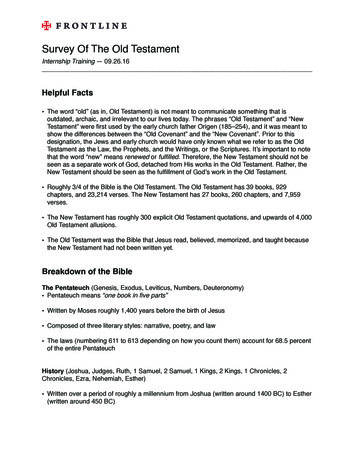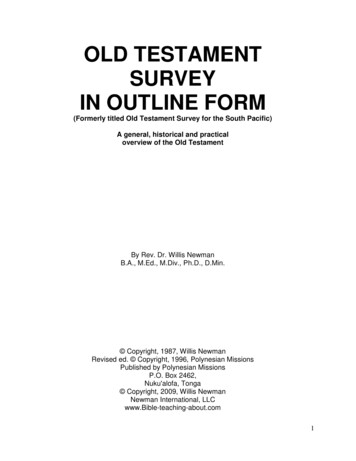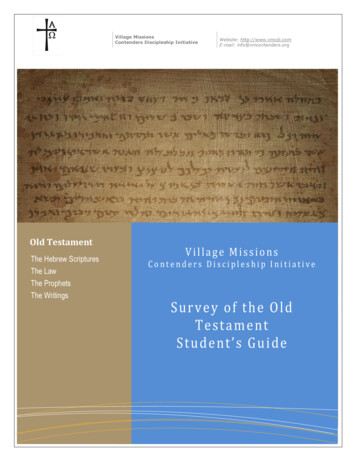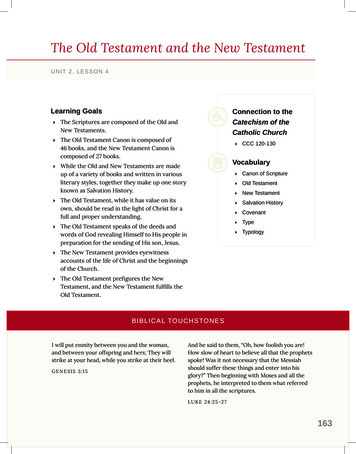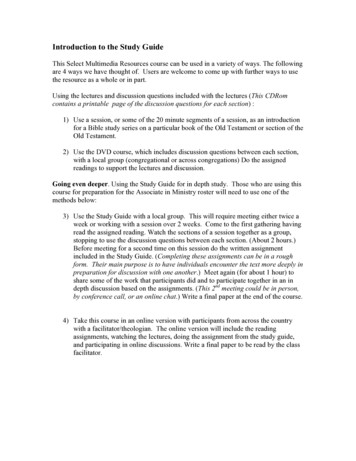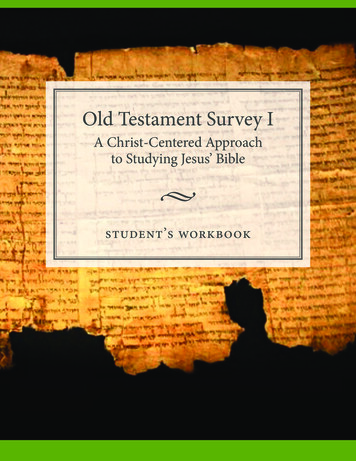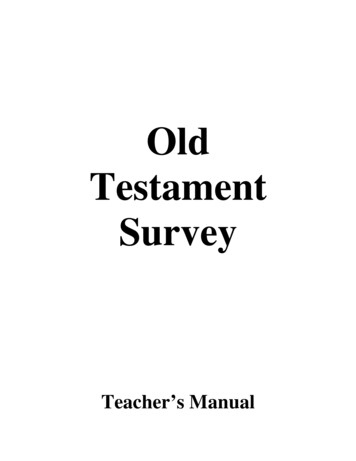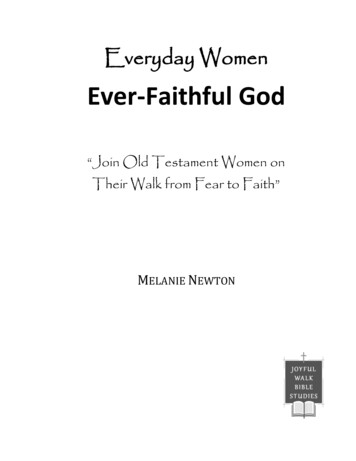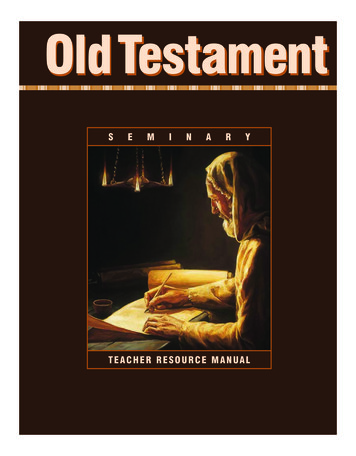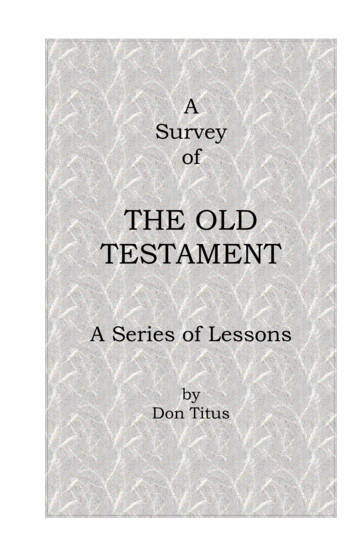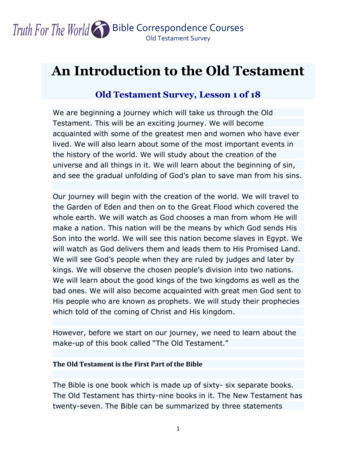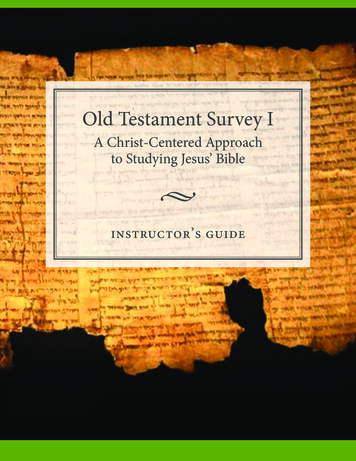
Transcription
Old Testament Survey IA Christ-Centered Approachto Studying Jesus’ Bible instructor’s guide
Old Testament Survey IA Christ-Centered Approachto Studying Jesus’ Bibleinstructor’s guideBethlehem College & Seminary720 13th Avenue SouthMinneapolis, MN 55415612.455.3420 612.338.6901info@bcsmn.edu bcsmn.edu
Copyright 2016 by Bethlehem College & SeminaryAll rights reserved. No part of this publication may be reproduced, modified,or transmitted in any form or by any means, electronic, mechanical, photocopying,or otherwise, without the prior written permission of the copyright owner.Scripture taken from The Holy Bible, English Standard Version. Copyright 2007 by Crossway Bibles,a publishing ministry of Good News Publishers. Used by permission. All rights reserved.
Old Testament Survey IA Christ-Centered Approachto Studying Jesus’ Bibleinstructor’s guideTable of ContentsInstructor’s IntroductionCourse SyllabusLesson 1Jesus' Bible: An OverviewLesson 2Getting the Big PictureLesson 3Genesis—Part 1Lesson 4Genesis—Part 2Lesson 5ExodusLesson 6LeviticusLesson 7NumbersLesson 8DeuteronomyLesson 9JoshuaLesson 10JudgesLesson 111–2 SamuelLesson 121–2 KingsAppendicesAppendix A: Key Chapters for Bible ReadingAppendix B: Big-Picture Bible Resources for Children1317437599123149171195217235259285287
Instructor’sIntroductionIt is our hope and prayer that God would be pleased to use this curriculum forhis glory. Thus, the intention of this curriculum is to spread a passion for thesupremacy of God in all things for the joy of all peoples through Jesus Christby equipping men, women, and young adults to serve as family, business andcommunity leaders, full-time Christian workers, missionaries, pastors, andteachers. This curriculum is guided by the mission and vision of BethlehemCollege & Seminary, which are more fully explained at bcsmn.edu. At theBethlehem website, you will find the God-centered philosophy that undergirdsand motivates everything we do. May God be glorified in us as we are satisfied inhim alone! Course DescriptionThe Old Testament Survey I: A Christ-Centered Approach to Studying Jesus’ Bibleis intended to survey the message of the Old Testament, both at the individualbook level and at the canonical level. That is, students will not only grasp themain message of each individual book of the Old Testament, but they willunderstand how that message contributes to the overall message of the Bible.Emphasis will be given to tracing the flow of redemptive history from thebeginning of time until the inter-testamental period, showing how the entireOld Testament points to, prepares the way for, and is fulfilled by Jesus theMessiah. This will be accomplished by reading What the Old Testament AuthorsReally Cared About in its entirety and the majority of Dominion and Dynasty, aswell as by first-hand study of some of the key biblical passages throughout theOld Testament.Instructor’s IntroductionTN
ObjectivesThis course is designed to accomplish specific objectives. A student successfullycompleting this course should be able to: Articulate the significance of the Old Testament for Christians today andunderstand how key biblical passages from the Old Testament fit into thestoryline of redemptive history.Explain the central message of each individual book of the Old Testamentand understand how each book contributes to the overall message of theBible.Understand how the entire Old Testament points to, prepares the way for,and is fulfilled by Jesus the Messiah.Discuss and apply the biblical truth that is presented in the curriculum toone’s own life.Magnify the worth of God in a more meaningful and personal way bytreasuring him in their heart above all else. We recognize that this, theultimate objective of the course, is impossible apart from the grace of Godin the working of the Holy Spirit, who exalts the risen Lord, Jesus Christ. ImplementationAs the instructor of this course, it is imperative that you are completely familiarwith the curriculum. We therefore recommend that you read this entire sectioncarefully and then skim through the rest of what is contained in this binder.This course is designed to be taught in 12 lessons, ideally in 2 hours of inclass instruction and with approximately 2.5 hours of homework each week.To achieve the kind of undistracted focus and academic rigor that maximizeslearning, we recommend that this course be taught as a weeknight class.We anticipate, however, that this curriculum might be adapted for aSunday school, small group, or discipleship setting. If this is necessary or mostappropriate, we urge you to establish an expectation among your students thatthis course will require more concentration and commitment than a typicalSunday school class would. A tone of serious and earnest study should be set bythe instructor before the course even begins.TNOld Testament Survey I
Before the first class session, you will need to decide when and where this coursewill be offered. Record this information on the syllabus in the box labeled:“Course Information.” You may also want to include your contact informationin this box. The schedule incorporated in the syllabus does not have assigneddates. Please write the intended dates for each lesson in the correspondingbox. Once you have completed filling out the syllabus, photocopy it so that youmay distribute one copy to each student enrolled in the course. The Student’sWorkbook does not include a syllabus, so your students will not have a syllabusuntil you distribute one. Photocopying the syllabus is the only photocopying thatis required of you by this curriculum.During the first lesson, we recommend the following outline to structureyour time: Welcome / Prayer (5 min): Greet the students as they arrive. Open thelesson by exalting God in prayer. Personal Introductions (25 min): Ask each student in the room tointroduce themselves briefly by answering the following questions (andanswer these questions yourself): What is your name? Can you tell the classa little about yourself? Why are you enrolled in this course and what are youhoping to gain from it? Syllabus Review (10 min): Distribute your customized course syllabusand then guide the class through it, reading each item and answering anyquestions that the students might have. Break (5 min) Lesson 1 —Jesus Bible: An Overview ( 60 min): Guide the class throughLesson 1. When you come to a question in the lesson, allow a few minutesfor the students to answer each question, and then pause to discuss theiranswers. Lesson 1 is the only lesson you will take your students throughwithout their prior preparation. For all subsequent lessons, students willwork through the lesson on their own before coming to class. To prepareyourself for this lesson, you should attempt to answer the questionsyourself before consulting the suggested answers in the Instructor’s Guide.Reading What the Old Testament Authors Really Cared About Chapter 1, asFirst LessonInstructor’s introductionTN
well as Dominion and Dynasty pages 15–43 is also strongly recommendedfor preparation (if you only have time to read one of these, read the firstchapter of What the Old Testament Authors Really Cared About). Be sure toengage your students during this lesson, especially because the informationpresented will be new to them! Subsequent LessonsTNOld Testament Survey IOverview of the Next Lesson / Closing (5 min): Encourage the students topurchase the required textbooks if they don’t have them already. Ensure thatthey understand what is required of them in preparation for the next classsession. Then thank them for coming to the class and dismiss in prayer.As the instructor, you will be expected to do all the preparation for each lessonthat is required of the students and more. We strongly recommend that youobtain a Student’s Workbook and attempt to complete the homework on yourown before consulting this Instructor’s Guide. The Instructor’s Guide provides oursuggested answers. Some questions in this curriculum are open-ended and couldbe answered in different ways. You may find that the answers contained in thismanual may not be the clearest or most accurate answers possible. Therefore,we encourage you to improve upon our answers if you can. It is essential tounderstand that this Instructor’s Guide is meant to be a resource; the realauthority is God’s Word.Furthermore, we have deliberately omitted lesson outlines for Lessons2-12. Our recommendation is to open the class in prayer. After that feel free tostructure the class however you think it will be most helpful. You may begin byreading (or having a student read) one of the significant passages found in thatweek’s lesson, or a text that stuck out to you in preparation for the class. Eachlesson includes a “Bible Study” section designed to dig a little deeper into one ofthe more significant texts of each book. You may utilize this passage to discussin class and discuss how it fits into the larger story of redemptive history. Oryou may simply proceed through each day’s study. The Discussion Questions atthe end of each lesson are also designed for class use. You may discuss these atany point throughout the lesson. As an integrative assignment, students will berequired to write a summary of that week’s book of the Bible (with the exceptionof Lessons 2 and 3). Leave time to discuss the integrative assignment at the endof class (see recommendations for this in the Teaching Notes for Lesson 4). Weconsider it unnecessary to lecture through the material the students will haveread in the various textbooks—discussing student questions on the readingshould adequately cover the material. You will notice that the material in each
lesson should provide you with much more material than you can coverin two hours of thoughtful interaction. This is not a mistake in design andyou should not feel obligated to provide the students with answers for everyquestion. Rather, as the instructor, your responsibility should be to focus onareas where students have questions or interest.You will also notice that the Instructor’s Guide has material that is not includedin the Student’s Workbook in the form of Teaching Notes at the beginning of thelesson and throughout the course, in the side margins. Consult these notes afterthoroughly reviewing the lesson.It is our conviction that the best teachers foster an environment in the classroomwhich engages students. Adults learn by solving problems or by workingthrough things that provoke curiosity or concern. Therefore, we discourage youfrom lecturing for the entire lesson. Although an instructor will constantly shapeconversation, clarifying and correcting as needed, they will probably not talk forthe majority of the lesson. This curriculum is meant to facilitate an investigationinto biblical truth—an investigation that is shared by the instructor and thestudents. Therefore, we encourage you to adopt the posture of a “fellow-learner”who invites participation from everyone in the class.It might surprise you how eager adults can be to share what they havelearned in preparing for each lesson. Therefore, you should invite participationby asking your students to share their discoveries. Here are some of our “tips”on facilitating discussion that is engaging and helpful: Teaching StyleDon’t be uncomfortable with silence initially. Once the first student sharestheir response, others will be likely to join in. If you cut the silence short byprompting the students, they are more likely to wait for you to prompt themevery time.Affirm answers whenever possible and draw out the students by askingfor clarification. Your aim is to make them feel comfortable sharing theirideas and learning, so be extremely hesitant to “shut down” a student’scontribution or “trump” it with your own. This does not mean, however,that you shouldn’t correct false ideas—just do it in a spirit of gentleness andlove.Don’t allow a single student or several students to dominate the discussion.Involve everyone and intentionally invite participation from those who aremore reserved or hesitant.Instructor’s IntroductionTN
Labor to show the significance of their study. Emphasize the things that thestudents could not have learned without doing the homework.Avoid talking too much. The instructor should not monopolize thediscussion, but rather guide and shape it. If the instructor does the majorityof the talking, the students will be less likely to interact and engage, and willtherefore not learn as much. Avoid constantly adding the “definitive lastword.”The instructor should feel the freedom to linger on a topic or question if thegroup demonstrates interest. The instructor should also pursue digressionsthat are helpful and at least somewhat relevant. The instructor, however,should attempt to cover the material. So avoid the extreme of constantlywandering off topic, but also avoid the extreme of limiting the conversationin a way that squelches curiosity or learning.The instructor’s passion, or lack of it, is infectious. Therefore, if youdemonstrate little enthusiasm for the material, it is almost inevitable thatyour students will likewise be bored. But if you have a genuine excitementfor what you are studying, your class will be impacted positively. Therefore,it is our recommendation that, before you come to class, you spendadequate time working through the homework and praying so that you canoverflow with genuine enthusiasm for the Bible and for God in class. Thispoint cannot be stressed enough. Delight yourself in God and in his Word!It may be necessary to again stress that this curriculum is a resource. Asthe instructor, you should feel the freedom to structure the class time and todiscuss through the material in a way that promotes the maximum learningand enjoyment of your students. Lingering on certain questions, pursuinghelpful digressions, examining relevant portions of Scripture, adding othersupplemental material, and customizing the curriculum to fit your situation areall heartily approved.Questions or Comments?TNOld Testament Survey IIf you still have questions after reading this introduction and surveying thecurriculum, you may contact Bethlehem College & Seminary at info@bcsmn.edu.We are also eager for your comments and suggestions! Thanks!
Old Testament Survey IA Christ-Centered Approach to Studying Jesus' Biblesyllabus Course DescriptionOld Testament Survey I: A Christ-Centered Approach to Studying Jesus’ Bible is intended to survey the message of theOld Testament, both at the individual book level and at the canonical level. That is, students will not only grasp themain message of each individual book of the Old Testament, but they will understand how that message contributes tothe overall message of the Bible. Emphasis will be given to tracing the flow of redemptive history from the beginningof time until the inter-testamental period, showing how the entire Old Testament points to, prepares the way for, andis fulfilled by Jesus the Messiah. This will be accomplished by reading What the Old Testament Authors Really CaredAbout in its entirety and the majority of Dominion and Dynasty, as well as by first-hand study of some of the keybiblical passages throughout the Old Testament. ObjectivesThis course is designed to accomplish specific objectives. A student successfully completing this course should be able to: Articulate the significance of the Old Testament for Christians today.Explain the central message of each individual book of the Old Testament.Explain how each book contributes to the overall message of the Bible.Understand how key biblical passages from the Old Testament fit into the storyline of redemptive history. Everylesson will compel the student to read and meditate on the Word. Our desire is to encourage students to beBereans (cf. Acts 17:11).Understand how the entire Old Testament points to, prepares the way for, and is fulfilled by Jesus the Messiah.Discuss and apply the biblical truth that is presented in the curriculum.Magnify the worth of God in a more meaningful and personal way by treasuring him in their heart above allelse. We recognize that this, the ultimate objective of the course, is impossible apart from the grace of God in theworking of the Holy Spirit, who exalts the risen Lord, Jesus Christ.syllabus1
Required books (Textbooks) An English version of the Bible (all quotes in this curriculum will come from the English Standard Version [ESV]unless otherwise noted).Jason DeRouchie, ed., What the Old Testament Authors Really Cared About (Grand Rapids: Kregel Academic &Professional, 2013). (abbreviated: WOTARCA)Stephen Dempster, Dominion and Dynasty: A Theology of the Hebrew Bible (Downers Grove: InterVarsity Press,2003). (abbreviated: DD) RequirementsStudents are expected to prepare for Lessons 2-12 by completing the lesson pages in a sequential order. Therefore,for each lesson a student should read the Introduction and the Lesson Objectives. Then the student should readthe remainder of the lesson, answer the 20 questions contained therein, and complete all the required reading andthe integrative assignment. The student may then review the discussion questions and record their own discussionquestion(s). Each lesson’s workload has been divided into five daily assignments for the convenience of the student.Though not required, a student may choose to read the book of the Bible that corresponds to each week’slesson. Another option is to read only the “Key Chapters for Bible Reading” that correspond to each week’s lesson( 1–2 Chs./day). These may be found in Appendix A.Students will pass this course if they attend at least 10 class sessions and complete all the assignments. Pleasecontact the instructor with any problems or concerns. ScheduleLesson2DateLesson Title1Jesus' Bible: An Overview2Getting the Big Picture3Genesis —Part 14Genesis —Part ges111 –2 Samuel121 –2 KingsOld Testament Survey I
Jesus’ Bible:An Overview IntroductionFor many Christians today the Old Testament gets overshadowed by the NewTestament, which generally receives far greater attention from the pulpit andindividual Bible reading. The result is that few people have a solid understandingof the Old Testament, its message, and its lasting value for Christians today. Formany, the Old Testament consists of little more than a handful of familiar storiessprinkled among more obscure ones. Little connection is drawn between the twotestaments, and, consequently, the crucial import of the Old Testament messageis rarely appreciated when one reads the New Testament. Some believe that themost Christians can glean from the Old Testament is moral examples—some tobe imitated and some to be avoided. And some would go so far as to say that theOld Testament has minimal value for the New Testament Christian.But is this the correct way to view the Old Testament? After all, it doescomprise a full 75 percent of our inspired Bible. Ought that much sacred text bedismissed or minimized so easily? The answer is a resounding “No,” and we willsee why in this lesson. In addition to understanding the significance of the OldTestament for Christians today, we will also look at its structure and see how itcontributes to the overall message of the Bible.1The extra-wide margin ishere to allow room for extranotes, questions, etc. Wehave occasionally includedadditional information orreminders that we hope willbe a help to you as you teach. Lesson ObjectivesAfter completing this lesson, the student should be able to articulate why the Old Testament is important for Christians today. understand the three-part structure of the Old Testament and itssignificance for the overall message of the Old Testament.Jesus’ Bible: An Overview3
TNOld Testament Survey I
Teaching NotesThe purpose of this first lesson is to introduce the students to each other and tothe course. The personal introductions suggested in the outline of the Instructor’sIntroduction are not frivolous. Rather, they should be a part of your deliberateeffort to create an atmosphere in which student contributions to discussion arevalued, respected, and engaged.As the instructor, you are encouraged to read pages 15–43 of Dominion andDynasty. Students will not be required to read this section, but it may helpto prepare you for the first lesson. It is important for the instructor to have afirm grasp of the issues presented in both books to facilitate and supplementdiscussion during the class periods. We would also encourage you to read someof the additional resources for further preparation.You may work through the material however you desire. It is notrecommended merely to lecture through the material. Try to engage yourstudents by discussing the questions presented, as well as any other questionsthat may have risen while you prepared for the lesson.If you’ve worked through this first lesson in the Student’s Workbook, you willhave noticed that there are a number of blank spaces in the boxes containingquotes from the reading. What appears as a blank space in the Student’sWorkbook appears in this Instructor’s Guide as an underlined word. Therefore,make sure to provide your students with the correct word to fill in the blank.Once the students have filled in all the blank spaces in each box, take a minuteto discuss the quote. These fill-in-the-blank quotes will be found through eachlesson.Jesus’ Bible: An OverviewTN
Study GuideJesus Only Had the Old TestamentThe fact that Jesus never read books like Romans, Corinthians, or Revelationmay come as a surprise. In fact, he never preached from the New Testament atall. Neither did Paul, Peter, or any of the other New Testament authors. In alltheir studying, preaching, and writing their only source of inspired text waswhat we now call the Old Testament. This means that all the passages in the NewTestament that speak about the importance of God’s Word for the Christianwere referring to the Old Testament when they were penned. Obviously, oncethe New Testament was completed these verses applied to the whole canon ofScripture, but it should still serve to increase our view of the value of the OldTestament for Christians in the church age.Consider these verses:Romans 15:4For whatever was written in former days was written for our instruction, thatthrough endurance and through the encouragement of the Scriptures we mighthave hope.42 Timothy 3:15–17And how from childhood you have been acquainted with the sacred writings,which are able to make you wise for salvation through faith in Christ Jesus.16All Scripture is breathed out by God and profitable for teaching, for reproof,for correction, and for training in righteousness, 17 that the man of God may becomplete, equipped for every good work.152 Timothy 4:2–4Preach the word; be ready in season and out of season; reprove, rebuke,and exhort, with complete patience and teaching. 3 For the time is comingwhen people will not endure sound teaching, but having itching ears they willaccumulate for themselves teachers to suit their own passions, 4 and will turnaway from listening to the truth and wander off into myths.24Old Testament Survey I
1. What are some ways you could use the Old Testament to provide hope,to reprove, to correct, or to train others in righteousness?·· answer. Answers will vary. The Old Testament is filled with promises ofa restored kingdom where God’s Son will rule in perfect righteousness andjustice. These promises are still valid and ought to provide hope for Christianswho live in a world that is broken by sin. (This is one possible answer).For Christians in the first century, the Old Testament was their Bible! Jesusidentified the Old Testament as the Word of God (Mark 7:13) and considered itto be authoritative (Matt. 12:1–3).2. Fill in the blanks as the instructor reads this quote:“Jesus was convinced that what is now the first three-fourths of our ChristianBible ‘cannot be broken ’ (John 10:35), would be completely fulfilledThe underlined words in thisquotation are left blank in theStudent Workbook. We suggest(Matt. 5:17–18; Luke 24:44), bore witness about him (Luke 24:27, 46; John 5:39, 46),that the instructor read theand called for repentance and forgiveness of sins to be proclaimed in hisquote aloud to allow studentsname to all the nations (Luke 24:47). All this Jesus summarized as ‘the good newsto check their work.of the kingdom of God ’ (Luke 4:43; cf. Acts 1:3)” (WOTARCA, 28). 1It is clear that Jesus and the New Testament authors had a high regard for theOld Testament, but why was this case?The Old Testament Speaks About Jesus and His KingdomThe reason the Old Testament is so important is because ultimately it speaksabout Jesus and his kingdom. Some people would argue that this is not the case.The Old Testament is concerned with Yahweh and his dealings with the Jewishpeople, while the New Testament is concerned with Jesus and his dealingswith Christians. But this thinking minimizes the unity of Scripture and placesa false dichotomy between the God of the Old Testament and the God of theNew Testament, as if they had a different mission in mind. In reality, there isonly one God in all of the Bible, and his primary concern is to display his gloryby establishing his kingdom among his one people. This message is intricatelywoven throughout both Testaments.1Jason DeRouchie, ed., What the Old Testament Authors Really Cared About (GrandRapids: Kregel Academic & Professional, 2013). Used by permission. No duplication ordistributed is permitted without written permission of the publisher.Jesus’ Bible: An Overview5
How do we know the Old Testament speaks about Jesus and his kingdom?Because Jesus himself tells us:Luke 24:25–27And he said to them, “O foolish ones, and slow of heart to believe all thatthe prophets have spoken! 26 Was it not necessary that the Christ should sufferthese things and enter into his glory?” 27 And beginning with Moses and all theProphets, he interpreted to them in all the Scriptures the things concerninghimself.25Luke 24:44–47Then he said to them, “These are my words that I spoke to you while I wasstill with you, that everything written about me in the Law of Moses and theProphets and the Psalms must be fulfilled.” 45 Then he opened their mindsto understand the Scriptures, 46 and said to them, “Thus it is written, thatthe Christ should suffer and on the third day rise from the dead, 47 and thatrepentance and forgiveness of sins should be proclaimed in his name to allnations, beginning from Jerusalem.443. What do these verses reveal about the Old Testament’s teaching on theMessiah (Christ) and his work?·· answer. The Messiah would die and be resurrected, and repentance andforgiveness of sins would be proclaimed in his name to all nations.The Messiah’s mission included a brutal death, resurrection on the third day, andproclamation of salvation through him, not just to the Jews, but to all nations.After his resurrection Jesus teaches his disciples that all of this was taught in theOld Testament. Luke, in writing the sequel to his gospel 2, sheds light on whatthis mission would accomplish. He says it would establish the kingdom of God(Acts 1:1–5; cf. Luke 24:44–49). In other words, what is called the Messiah andmission in Luke 24 is called “kingdom of God” in Acts 1:3. This was the coremessage of Jesus’ teaching (cf. Matt. 4:17, 23; 9:35).Matthew 4:17From that time Jesus began to preach, saying, “Repent, for the kingdom ofheaven is at hand.”172Luke wrote both the Gospel of Luke and the Book of Acts (Luke 1:1–4; Acts 1:1).They are best read together because Acts continues the story begun in the gospel.6Old Testament Survey I
The book of Acts reveals that Paul’s ministry is simply an extension of Jesus’work:Acts 26:22–23To this day I have had the help that comes from God, and so I stand heretestifying both to small and great, saying nothing but what the prophets andMoses said would come to pass: 23 that the Christ must suffer and that, by beingthe first to rise from the dead, he would proclaim light both to our people andto the Gentiles.22Acts 28:23When they had appointed a day for him, they came to him at his lodging ingreater numbers. From morning till evening he expounded to them, testifyingto the kingdom of God and trying to convince them about Jesus both from theLaw of Moses and from the Prophets.23Acts 28:30–31He lived there two whole years at his own expense, and welcomed all whocame to him, 31 proclaiming the kingdom of God and teaching about the LordJesus Christ with all boldness and without hindrance.30Paul was “testifying to the kingdom of God and trying to convince them aboutJesus both from the Law of Moses and from the Psalms.” Earlier, we saw Jesususe “Moses and all the Prophets” to interpret to the men on the road to Emmaus“in all the Scriptures the things concerning himself.” And to his disciples Jesussaid, “Everything written about me in the Law of Moses and the Prophets andthe Psalms must be fulfilled.” Clearly the Old Testament spoke about Jesus andhis kingdom.4. Have you ever considered that you could learn about Jesus from the OldTestament? Record any thoughts or reactions you may have in hearingthis.·· answer. Answers will varyJesus’ Bible: An Overview7
If you were to search the Bible for the phrases “kingdom of God” or “kingdomof heaven,” the results might surprise you. “Kingdom of God” shows up 67times in the New Testament and “kingdom of heaven” occurs 32 times. Neitherphrase occurs in the Old Testament—not even once! However, the conceptof God’s kingdom is found on nearly every page. And with all the teachingon the kingdom in the New Testament, we must assume that Jesus’ audienceunderstood what he meant by the “kingdom of heaven” (Matt. 4:17; cf. 3:2). Sohow did the Law, the Prophets, a
Old Testament points to, prepares the way for, and is fulfilled by Jesus the Messiah. This will be accomplished by reading What the Old Testament Authors Really Cared About in its entirety and the majority of Dominion and Dynasty, as well as by first-hand study of some of the key biblica
